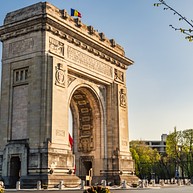
-
![The beautiful Strada Postei street in the Lipscani district, in a moment of tranquility without people, historical center of Bucharest, Romania]() Provided by: Marco Taliani de Marchio/shutterstock
Provided by: Marco Taliani de Marchio/shutterstock

Our travel guides are free to read and explore online. If you want to get your own copy, the full travel guide for this destination is available to you offline* to bring along anywhere or print for your trip.
*this will be downloaded as a PDF.Price
€4,95
Lipscani District
The guide was updated:Lipscani, Bucharest’s historical centre, retains an irresistible old town charm. It is located between Calea Victoriei, Boulevard Bratianu, Boulevard Regina Elisabeta and the Dambovita River. Its collection of winding streets boasts antique markets, bric-a-brac spilling out from tiny boutiques and some of the city’s most appealing restaurants and bars.
Useful Information
- Address: Lipscani, București

From EUR 0
Lowest price guaranteedDigital Travel Guide Download
Our travel guides are free to read and explore online. If you want to get your own copy, the full travel guide for this destination is available to you offline* to bring along anywhere or print for your trip.
*this will be downloaded as a PDF.Price
€4,95

Originally built to house all offices of the Communist ruling officers during Ceausescu’s regime, the imposing Palace of Parliament is Romania’s most famous building. Tours are open to the public, showing off the opulent staircases and chandelier-filled rooms and offering great insight into the building's history. The palace also houses Romania's National Museum of Contemporary Art.
There are tours available all year round; however, it's essential to reserve your tour slot beforehand, as advance booking ensures availability for this captivating experience.
Bookable
Read more

Triumphal Arch
Similar to its Paris namesake, Bucharest’s Triumphal Arch, standing tall at 26 metres, remembers Romania’s Great War soldiers and its reunification in 1918. Initially, the arch was built out of wood in 1922, and was then finished in Deva granite in 1936.
The Triumphal Arch becomes the main stage for the military parade every December 1st, when Romanians celebrate their National Day.
Bookable
Read more

Lipscani District
Lipscani, Bucharest’s historical centre, retains an irresistible old town charm. It is located between Calea Victoriei, Boulevard Bratianu, Boulevard Regina Elisabeta and the Dambovita River. Its collection of winding streets boasts antique markets, bric-a-brac spilling out from tiny boutiques and some of the city’s most appealing restaurants and bars.
Bookable
Read more

National Museum of Art
Romania’s most impressive art collection is displayed in the old sprawling royal palace. Here you can see works by Rembrandt and El Greco among a great collection of European art assembled by the Romanian royal family, as well as works by celebrated Romanian artists.
Read more

University of Bucharest
In addition to being the centre for Bucharest’s intellectual and political events and the most popular meeting place in the city, the University of Bucharest has a dramatic history. During the 1989 Revolution, some of Romania’s fiercest fighting took place here. Close by you can find the University of Bucharest’s School of Architecture, the National Theatre, the Coltea Hospital and the Sutu Palace History Museum.
A Christmas market is held at the University Square every year, but you can find excellent restaurants and cafes in the area all year round.
Read more

Romanian Athenaeum
The Romanian Athenaeum concert hall is home to the superb Filarmonica George Enescu and the hub of Bucharest’s musical activity. Exquisite mosaics and historical frescoes adorn the 19th-century circular building, which hosts impressive orchestral concerts and other performances.
You can visit the ornate, domed, circular building without attending a concert, too.
Read more

Museum of the Romanian Peasant
This delightful museum opened in 1906 and is widely regarded as Romania’s best, a veritable treasure trove of pottery, icons and clothing. It also houses the fascinating Communism Exhibition and the ruins of an 18th-century Transylvanian wooden church.
Read more

Jewish Museum Bucharest
This museum, situated in a stunning former synagogue built in 1850, tells the tragic story of Romania’s Jewish population in the country, and their important contributions to Romanian culture and history. Make sure to catch the moving tour to get the best experience.
Read more

Revolution Square
While the University of Bucharest Square saw some of the darkest days of Ceausescu’s regime, events at the Revolution Square heralded the beginning of a new age. Close by is the former Royal Palace, now home to the National Art Museum, the Romanian Athenaeum and the Athenee Palace Hotel.
Read more

Carol Park
Named after King Carol I of Romania, this park, designed by a French landscape architect, offers lush vegetation and panoramic views of Bucharest. You can find plenty of open-air concerts in the summer at Arenele Romane, or simply enjoy the fresh air and green spaces at any time of year.
The park also includes several monuments, such as a Mausoleum, the Cantacuzino Fountain built in 1870 and Fântâna Minelor și Carierelor fountain completed in 1906. The Giants' Statues and the Zodiac Fountain can also be found here. The Technical Museum is a great place to explore Romanian history of technology.
Read more

Stavropoleos Monastery Church
Stavropoleos Monastery Church in Bucharest is a striking example of Romania's Brâncovenesc style, blending Byzantine, Ottoman, Renaissance and Baroque influences. Built in 1724 by Ioannikios Stratonikeas, this religious monument features polyfoil arches, arabesque patterns and an impressive iconostasis. Housing a rich collection of 18th-century icons and ecclesiastical objects, it's a testament to Romania's artistic and spiritual heritage.
Read more

Dimitrie Gusti National Village Museum
Discover Romania's diverse heritage at the Dimitrie Gusti National Village Museum. This open-air ethnographic treasure displays over 270 historic buildings, traditional homes, windmills and artefacts from various regions of Romania, offering a vivid journey through Romania's rural past. The museum is set in the scenic Herăstrău Park, officially King Michael I Park.
Read more

Herăstrău Park
King Michael I Park, still referred to by locals as Herăstrău Park, spans 187 hectares around a picturesque lake. Renowned for its serene beauty and sheer size, the park offers an escape from the urban hustle. Enjoy boating on the lake, exploring the Japanese Garden, or simply unwinding amidst nature. This green oasis reflects the city's heritage and is perfect for leisurely strolls or vibrant outdoor activities.
Read more

Cișmigiu Gardens
Cișmigiu Gardens, the oldest park in Bucharest designed by Carl Meyer in the 1850s, features a stunning rose garden in the north and a classic French garden on the west. Stroll along its tranquil paths or rent a boat to explore the largest lake, complete with its own island. This charming park offers a peaceful retreat, steeped in the city's history and elegance.
Read more

ARCUB
ARCUB is a cultural gem in Bucharest's Lipscani district, showcasing the city's identity through various artistic expressions. This Art Deco marvel, completed in 1934, now hosts over 200 yearly events, highlighting artists beyond conventional institutions. Its elegant 320-seat auditorium, accessible via a grand staircase, is a testament to the rich cultural tapestry of Bucharest.
Read more

Romanian Patriarchal Cathedral
The Romanian Patriarchal Cathedral, founded in the 1650s by Prince Constantin Șerban, stands as a beacon of faith and history on Dealul Mitropoliei. Known for its Brâncovenesc style façade and a cappella choir, the cathedral is a key site for Orthodox observances in Bucharest. It houses the relics of Saint Dimitrie Basarabov, patron saint of the city, and offers stunning city views, especially at sunset.
Read more

